Topic 5: Evolution and biodiversity
5.4 Cladistics
Cladogram:
- Cladogram is a tree diagram showing the similarities and differences between different species
- Branching points on the cladgram is called nodes
- Nodes denote a speciation event when a common ancestor splits into two or more species
- These groups of species evolved from a common ancestor, that have shared characteristics is called a clade
- Sometimes determining which species are part of a certain clade is difficult
- The most accurate evidence is derived from amino acid sequences of certain proteins, such as Hemoglobin and Cytochrome C and from base sequences of genes

Time correlation:
- Differences in the base sequence of DNA are caused by mutations. These gradually accumulate over time.
- Rate at which mutations occur can be used as a molecule clock to calculate how long ago specie diverge.
- By sequencing nuclear DNA and mitochondrial DNA, we can establish a biochemical phylogeny between species to show common ancestry
- The difference in the sequences can be used to deduce when a certain species split from a common ancestor
Analogous structure:
- Some animals belonging to different groups live in the same or similar habitat
- This can lead to development of similar superficial structures for organisms that live in a similar manner
- The structures look comparable anatomically from the outside; however, are not alike on the inside (do not share a common ancestor)
- They are similar traits but not from a common ancestor
Homologous structure:
- Common internal structures that are similar in seemingly dissimilar animals that have evolved from a common ancestor.
- The standard example of homologous structures is the “pentadactyl limb” which is the five digit limb found in animals such as humans, dolphins, bats, and dogs.
- Even though the shape, size and function of this structure vary between species, the general structure and position of the bones in these limbs are the same
Reclassification:
- Since evidence from base and amino acid sequences only became possible in the mid to late 1900’s, some changes have occurred in traditional classifications of certain plants and animals based solely on morphology
- Cladistics has provided evidence that shows some morphologies do not match the evolutionary origins of the groups of organisms they were put in to
- As a result some groups have been reclassified, some groups have merged or divided, and in some cases, some species have been moved to another group
- This process is time consuming; however, the new classifications based on cladistics, give a clear and more concise view of an organism’s true natural classification
- An example of the reclassification of an organism is the Family Scrophlahulariaceae
- At one point this family consisted of over 275 genera and 5000 species
- Scientists recently used cladistics to reclassify the Figworts family
- They focused on the base sequences of three chloroplast genes and discovered that the species in the Figwort family were not one clade but five clades and had been incorrectly grouped together into one family
